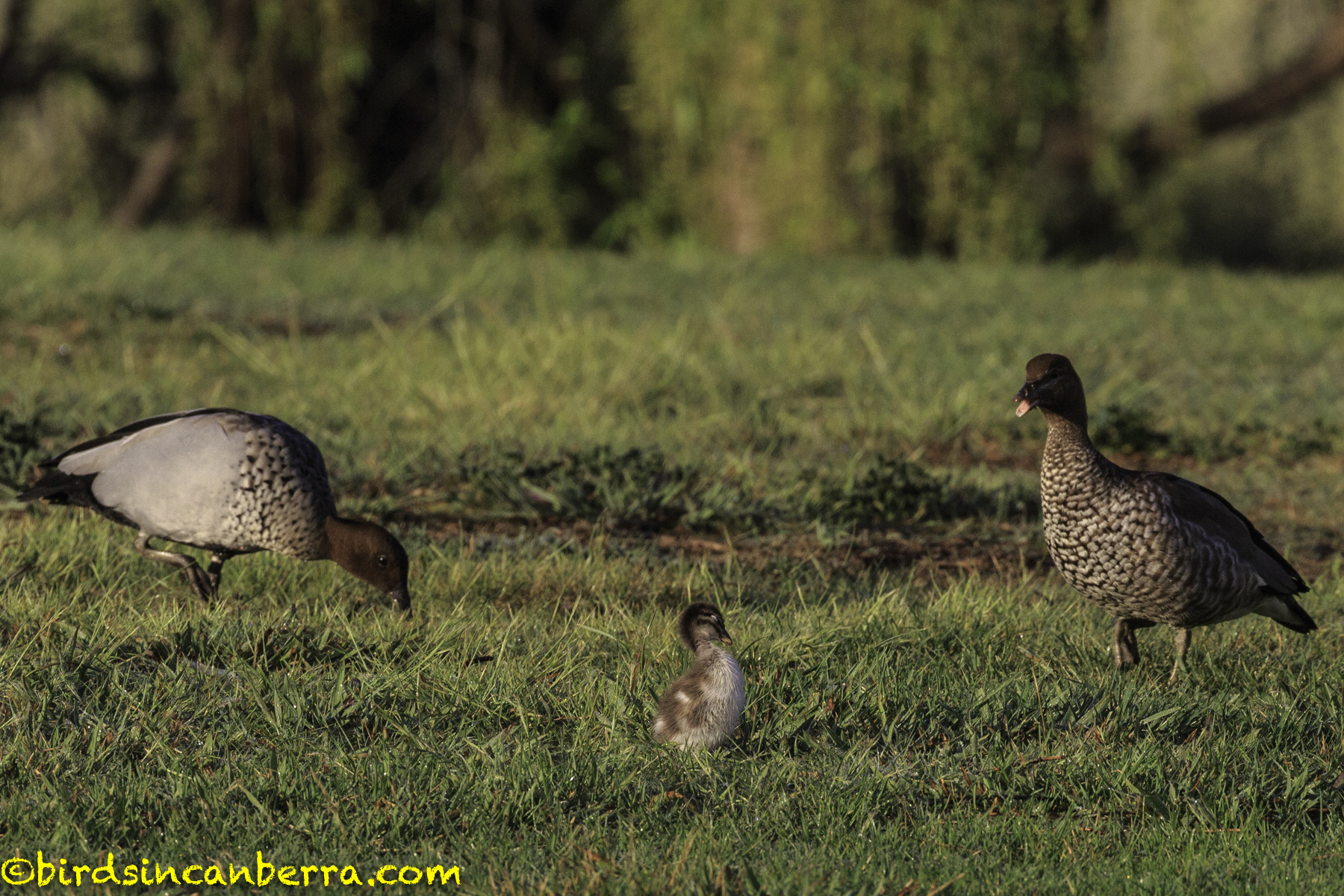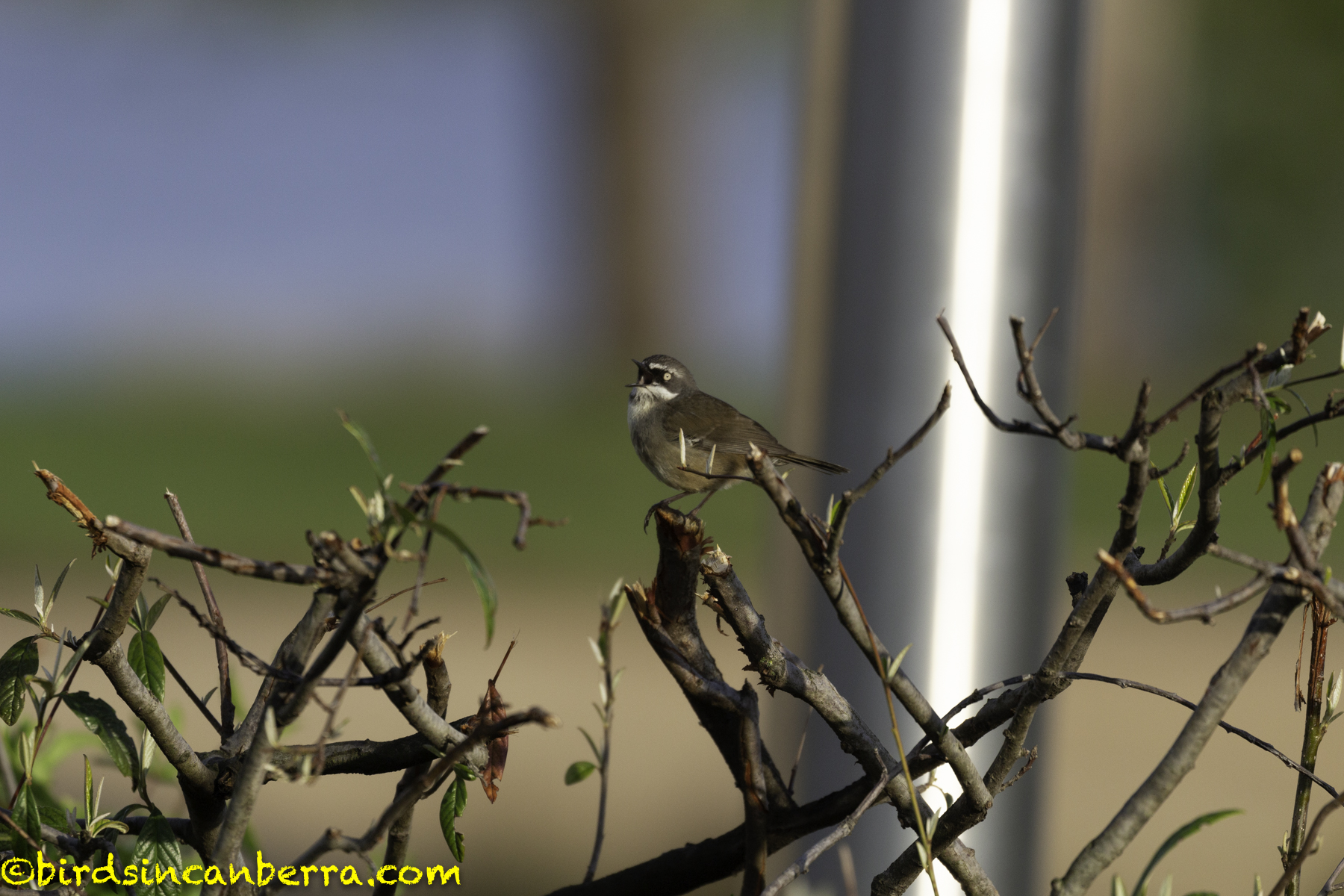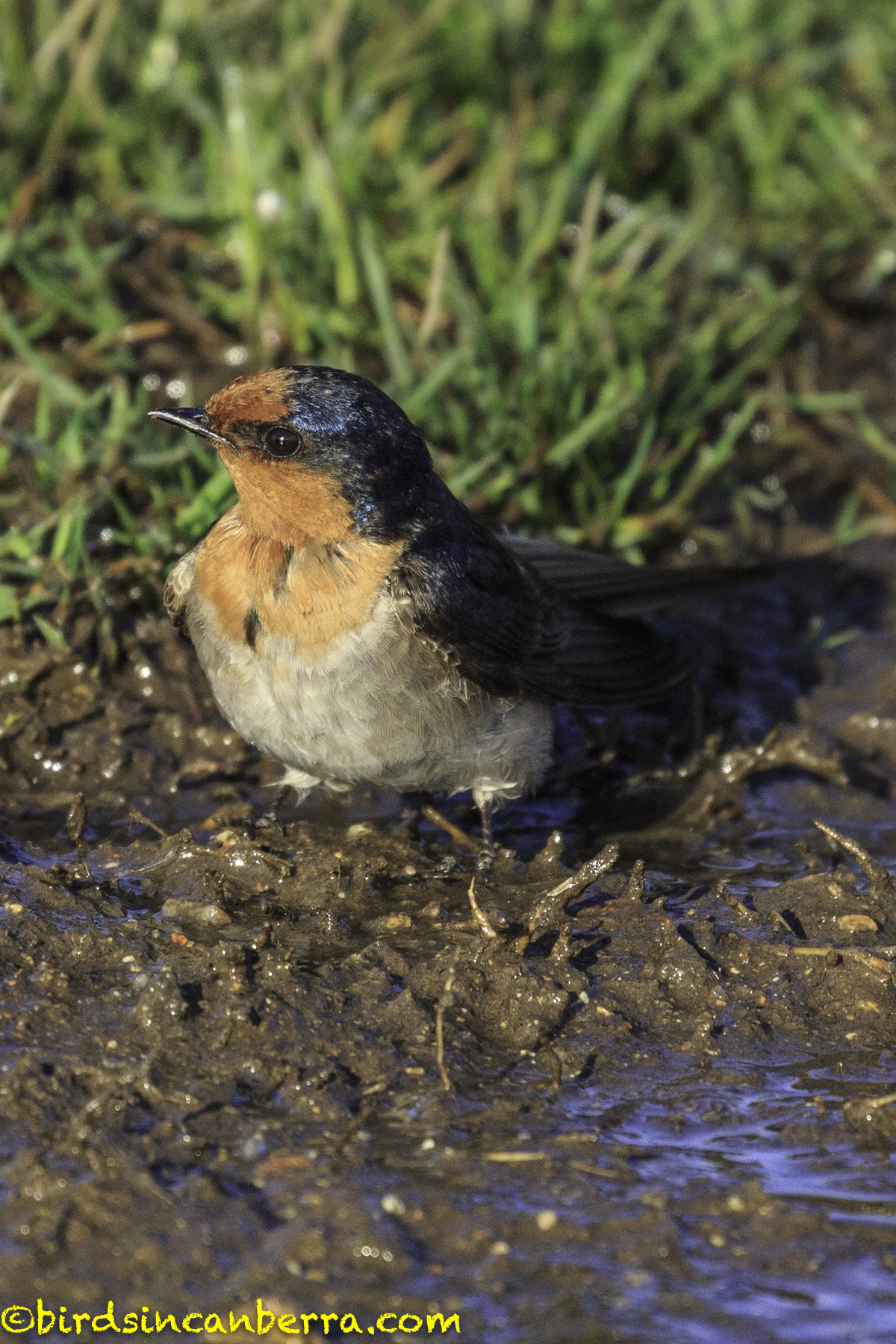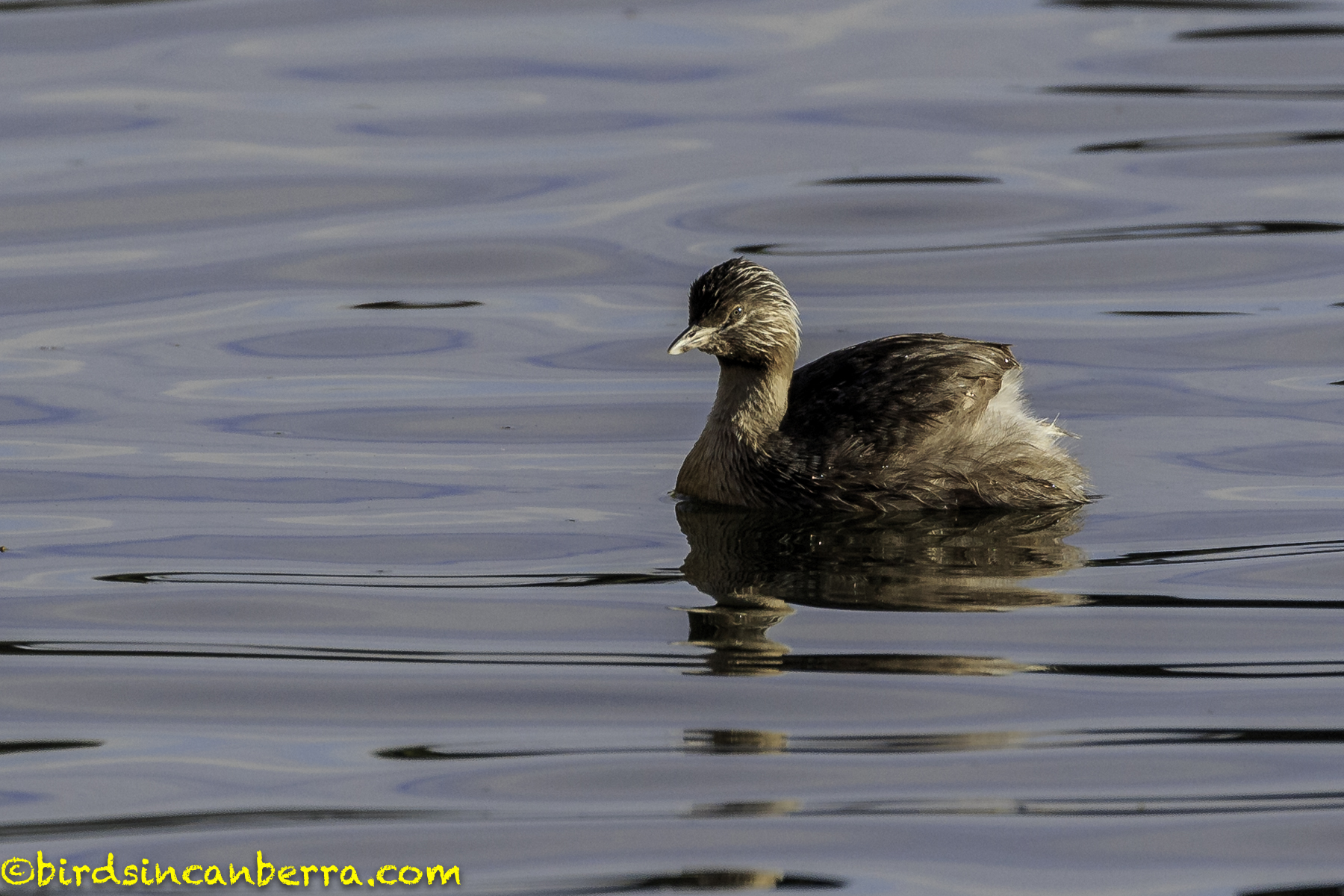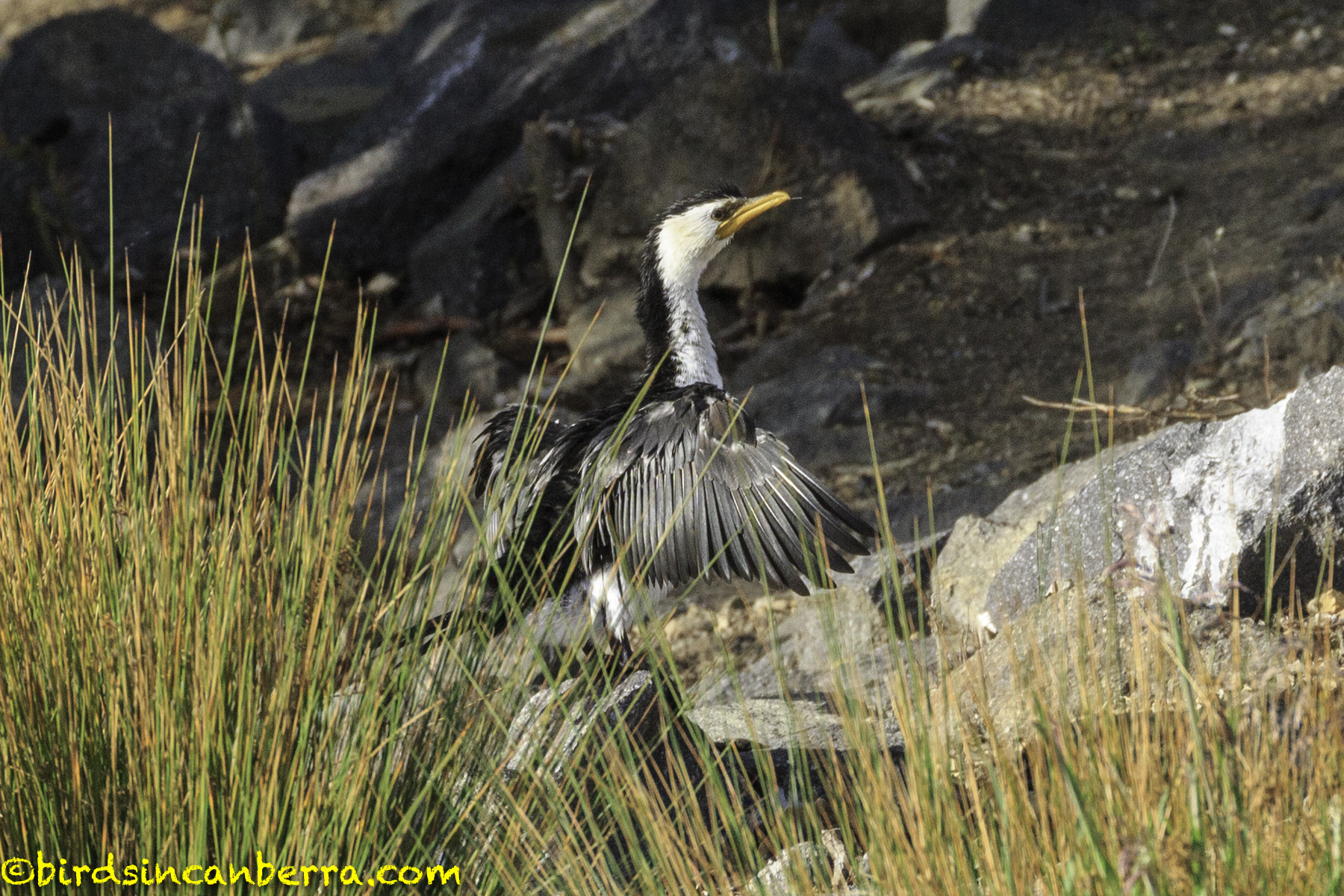The National Carillon sits on Aspen Island in Lake Burley Griffin. I had often thought about going there to photograph birds and since I am taking time off work at present this Tuesday seemed a good opportunity to see what it was like. Although it was a small island, I was happy with the number of birds I saw. The Welcome Swallow picture that heads this post was one of the first birds I saw on the day, presaging a great opportunity to look at how swallows gather mud for their nests. The cute metre was high with some ducklings wandering on the island. While I was at the lake, I went on a bit further to look at the birds around Commonwealth Park, including hearing then seeing an Australian Reed Warbler.
As soon as I arrived there were two Silver Gulls having breakfast from the remnants of a meal in a discarded McDonalds bag in a car park space near by. My presence disturbed them enough to make the birds move away. The sky was overcast and as I had not fitted my powerful flash I had to rely on my internal flash. I realised later it only allowed the camera to take photos at 1/200 shutter speed at the fastest, hence why there is some blur on the birds. Lesson learned, fit my external flash when I had out as I never know when it will come in handy.
There were two species of ducks on the island, one of them were Pacific Black Ducks. This particular bird in the photograph was on the western side of the island doing some morning preening,
In one of the willow trees a lone Silvereye was making its way through the branches. I love the way it is hanging upside down in the photograph to get at the plant. It was moving quickly between branches making it hard to obtain a decent photograph.
Another group of birds in the willow trees were Red-rumped Parrots. It was too much of a challenge to get a photo of them in the tree because of the overcast conditions and the shadow from the willow’s canopy but then some flew down to the lake’s edge. I thought they may be going in to bathe but they just walked along the edge. Shortly after this shot the birds flew off. Fortunately, the photograph does show the amazing colour of their plumage, even if the red of their name is not as clear as it should be from this angle.
Apart from the Pacific Black Duck mentioned above there were a number of Australian Wood Ducks on the island in what appeared to be pairs. I also saw my first ducklings of this breeding season. The first four photos show the three I saw with this pair of adult ducks. The parents were being very protective keeping other birds away. In photograph five, the male was lining up on a duck he thought was too close to the ducklings. Photograph six shows the female chasing away a separate duck. The parents also kept their distance from me, shepherding the ducklings in the opposite direction if they thought I was too close. The ducklings appeared to be happily eating the grass the whole time I was observing them. I included photograph four as it was the only time I saw a duckling do something else rather than walk and eat, it was having a good itch.
I heard this White-browed Scrubwren well before I saw it. The bird was moving through one of the hedges on the island. It appeared to be by itself. It mainly stayed down low but as can be seen in the photos came up to the top of the shrubbery at least once to call out.
Apart from the Welcome Swallow I have at the top of this post I photographed a number of other swallows, although the light was not such that I could try fast shutter speeds to catch them in flight. I saw these six swallows landing in a mud puddle so they could take the mud back to build their nests. They were not worried about my presence so I edged closer to the mud puddle each time they departed. The first photograph was taken from just a few metres away, staying still behind my camera so as not to create too much movement. The second photo shows how much a swallow will open its beak to get some mud. I noticed the swallows seemed to be particular about their mud, as it was only from one of the mud puddles. Even when I was only a few metres away, and there was another mud puddle further from me, which some swallows landed at but rejected, the birds kept returning to this mud puddle. I am not sure if the mud was wetter here, so softer, or whether there was more plant matter in the mud making it easier to bind later at the nest. Photos three, four and five are of the same bird taken successively showing that it took several goes to get a large amount of mud before it flew off. The birds appeared to collect mud together, in that they would arrive at roughly the same time, swoop around the area at low height; land to start collecting mud; then all depart together. It was. case of there were swallows, then no swallows, then swallows. If one arrived, they were all coming. After flying off I could not track them visually, my eyes are not what they used to be, but they appeared to be flying towards the wall leading to Kings Avenue bridge. I was really surprised about how the swallows seemed unconcerned by my presence, appearing slightly hesitant, when I was at my closest, but still landing. Photo six is a lucky shot of a bird landing and was taken when I was still a little distance from the birds.
There was a lone Black-faced Cuckoo-shrike on the island. A Noisy Miner was doing its best to disturb it but the cuckoo-shrike was not being scared off. There was also a Brush-tailed Possum nearby, trying to apparently curl up in the open part of where the top of the tree had come away. I am not sure if this was making the bird uneasy as possums will eat eggs and young birds, although I could not hear a second bird nor did this one seem to be attacking the possum.
This is the back of the Brush-tailed Possum I was talking about above. When I first saw it, I noticed its black, bushy tail hanging down the side of the tree trunk making the animal very visible. It looked like it was trying to curl up into this tree but it was taking a long time getting in, and as can be seen, there was not much shelter from the daylight. The other option was it was having one last attempt at getting food before it went to sleep.
As I was walking back over the bridge connecting Aspen Island to the foreshore I noticed this Hoary-headed Grebe in breeding plumage. It was either staring intently at the wall around the island, as it was always pointing that way, or was allowing the sun to warm its back. If it was looking at the wall I could not see what it was so interested in, the wall looked to be empty of life. I thought the bird was drifting towards me with the wind but it must have been swimming underwater imperceptibly as it actually moved away from where I was on the bridge. The name refers to the breeding plumage on the head which gives the bird a frosted appearance or the look of a greying old man with his hair slicked back, according to this book.
After looking at the grebe I was distracted when a Little Pied Cormorant landed in the water on the other side of the bridge, before walking out of the water to dry its feathers. It stopped momentarily at the edge of the water, photo one, before moving higher up the bank, photo two. I did note the white downy feathers stuck to its wing, which may have been in the water from other birds when it was swimming,
Stepping back onto the foreshore, the first bird I saw was an Australian Raven. It was making a meal of a carp a fisherman had discarded, because the law in Canberra is once a carp is caught it cannot be returned to the water, as part of the effort to control the damage caused by this introduced species. Initially there was only one bird eating the carp, then a second Raven arrived. There was no fighting, the first bird simply had a last bit of food, photograph three and flew off, then next bird started eating, the last photograph.
This Red Wattlebird landed on a branch at almost eye level. There was a pair of them moving around Commonwealth Park. The lighting was horrible and I still had not attached my better flash to my camera so I was using the in-camera flash, which meant the camera made the shutter speed, even if I was on manual mode.
The final bird I saw was this lovely Australian Reed Warbler. I first heard its harmonies call then I went looking for it and saw it in the reeds near one of the ponds. When I returned to the same area a little while later it was in a shrub, which was tightly grown, beside the pond such that I could hear the bird but I had no hope of seeing it. The warbler eventually returned again to the little clump of reeds I had seen it in. I heard at least one other warbler calling, possibly responding to this one as they seemed to take it in turns to sing. The photos below also show the way the feathers on the crown fluff up when the bird makes a call.





